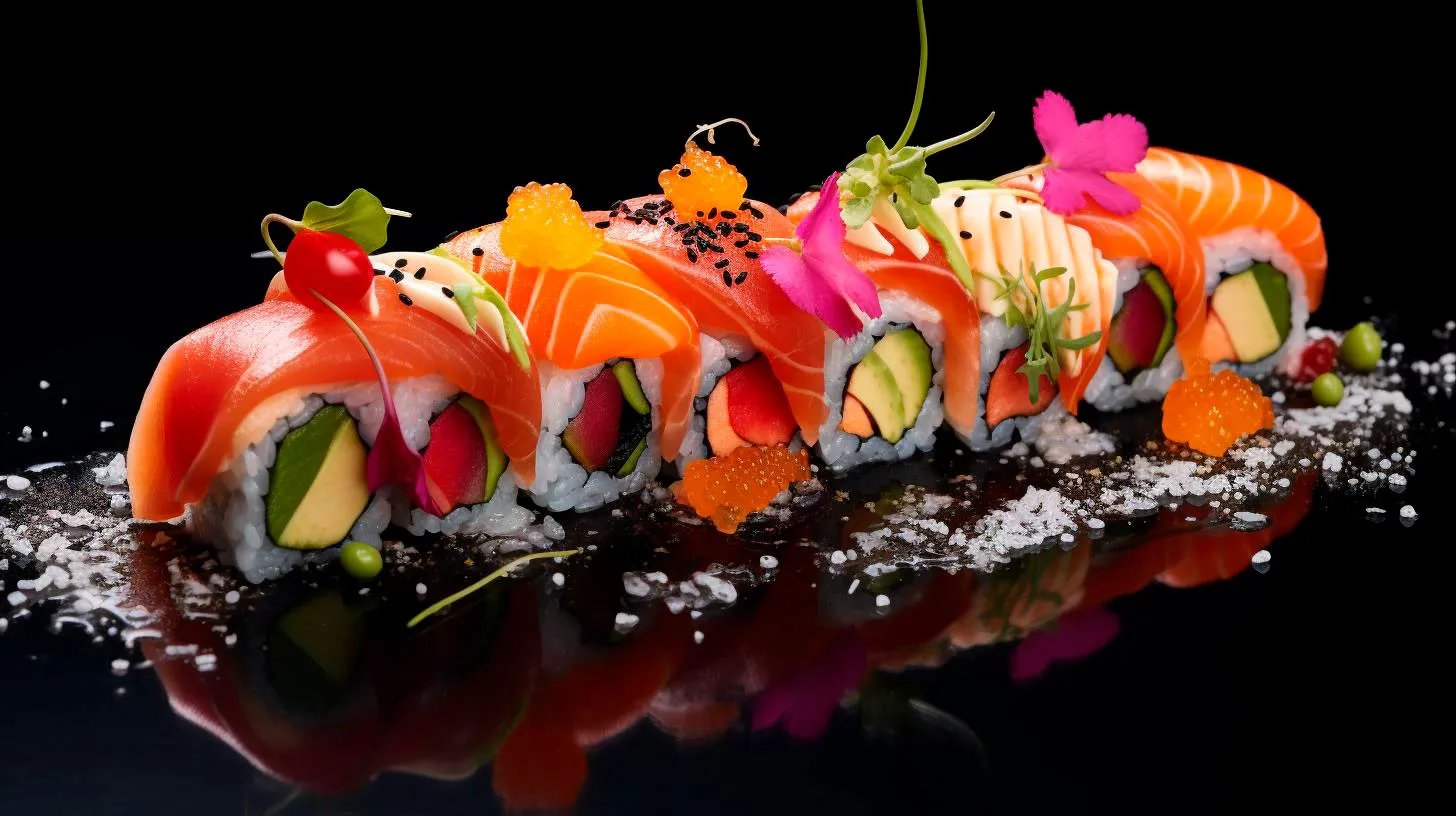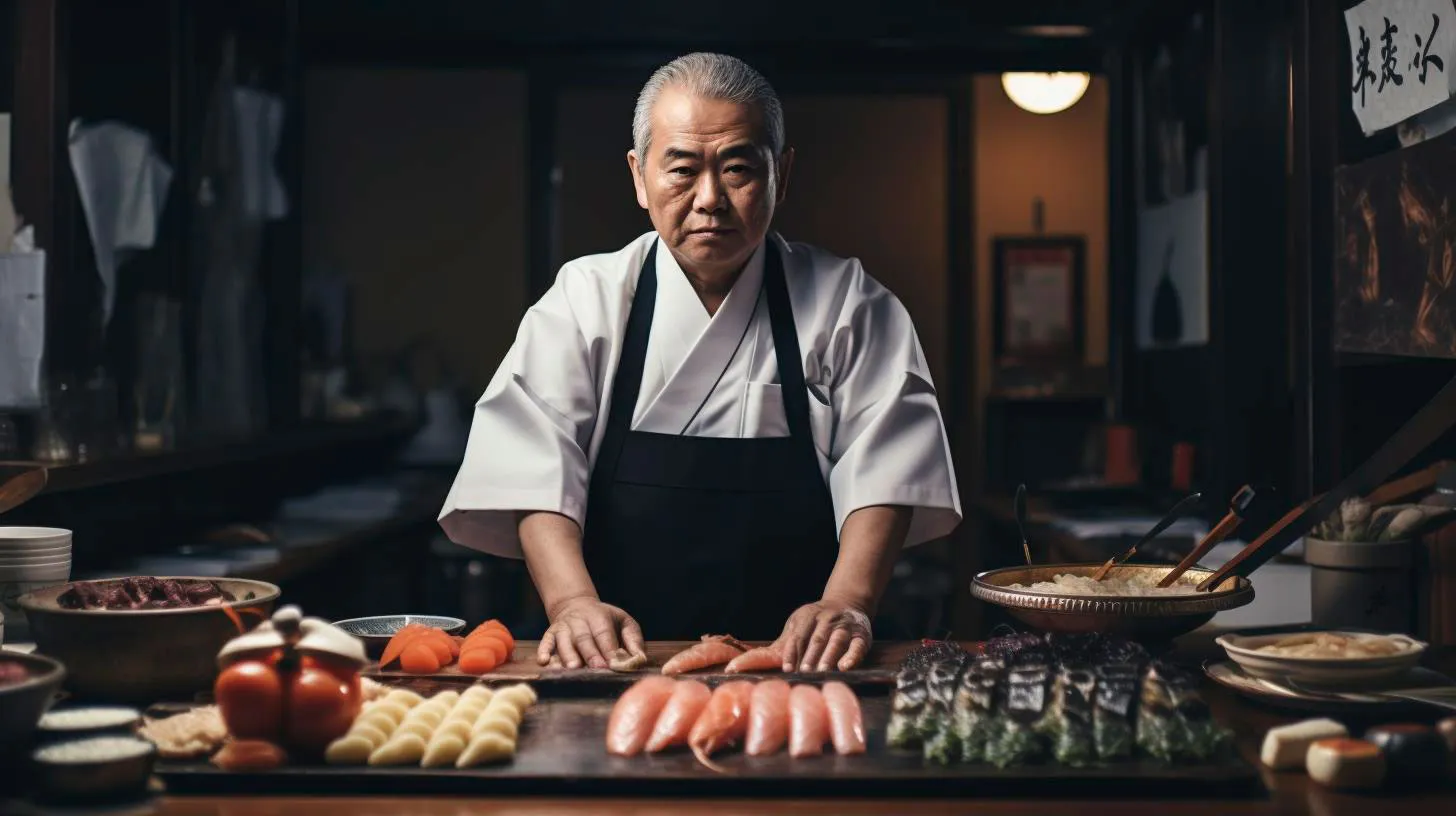Savoring Sushi: How Freshness and Skill Combine for a Heavenly Dining Experience
It’s the perfect marriage of freshness and skill.
Sushi’s exquisite taste and texture largely depend on the freshness of its ingredients. From the succulent fish to the perfectly seasoned rice and seaweed, every element must be of the highest quality. Freshness is paramount in sushi, as it guarantees the delicate flavors and natural sweetness of the ingredients remain intact.
Freshness: Key to Sensational Sushi
When it comes to sushi, there are a few crucial factors that determine its freshness:
- Sashimi-grade fish: The quality of fish used in sushi is paramount. It should be sourced from reputable suppliers who ensure it is safe for raw consumption. Freshness can be judged by its texture, color, and smell.
- Seasonal ingredients: Sushi chefs take pride in using seasonal ingredients to enhance the flavors and experience. These ingredients, sourced at their peak freshness, provide a delightful and authentic dining experience.
- Proper storage and handling: Sushi ingredients must be stored and handled with utmost care. Temperature control and quick turnover are essential to maintain freshness and prevent spoilage.
Only when these factors align can sushi be truly extraordinary, delighting our taste buds and leaving a lasting impression.
The Artistry of Sushi Chefs
Aside from the freshness of ingredients, the skill and artistry of sushi chefs play a pivotal role in creating an exceptional sushi experience.
Sushi chefs undergo years of training to perfect their craft. They master the technique of selecting the finest ingredients, meticulously slicing the fish, and expertly molding the rice. Each step requires skill, precision, and an eye for detail to ensure every piece of sushi is a small work of art.
Here are some remarkable skills sushi chefs possess:
- Nigiri proficiency: Sushi chefs are adept at crafting nigiri, the most traditional form of sushi. They expertly shape the rice and delicately place a slice of fish on top, ensuring a harmonious balance of flavors and textures.
- Knife skills: Perfect knife skills are crucial for sushi chefs. They must slice the fish with precision, making each cut count, resulting in beautifully presented sushi pieces.
- Sauce and seasoning mastery: Sushi chefs have a deep understanding of flavor profiles and employ various sauces and seasonings to enhance the taste of sushi without overpowering it.
The mastery of these skills enables sushi chefs to create an unforgettable dining experience, where each piece of sushi is a work of art that reflects their passion and dedication.
The Joys of Savoring Sushi
When you indulge in a piece of sushi, you embark on a culinary journey filled with sensory delights:
- Exquisite flavors: Sushi combines the natural sweetness of fish, the umami of seaweed, and the delicate taste of vinegared rice. Every bite explodes with an array of flavors that dance on your palate.
- Textural bliss: Sushi offers a symphony of textures. From the tender fish to the slightly chewy rice and crisp seaweed, each bite delivers a delightful combination of sensations.
- Visual feast: The vibrant colors, meticulous presentation, and artistic garnishes make sushi a feast for the eyes. It’s an intricate display of culinary craftsmanship.
These combined elements make savoring sushi an unforgettable experience that elevates dining to an art form.
Key Takeaways:
- Sushi’s freshness is crucial in preserving the delicate flavors of its ingredients.
- Seasonal ingredients and proper storage play a significant role in ensuring optimal freshness.
- The artistry of sushi chefs is essential in creating visually stunning and delectable sushi.
- Sushi offers a symphony of flavors and textures that delight the senses.
Savoring sushi is more than just a meal; it’s an exploration of taste, craftsmanship, and culture. Whether you’re a sushi aficionado or a newcomer to this remarkable cuisine, the freshness and skill that go into creating sushi will ensure a heavenly dining experience that you’ll savor for a lifetime.
Exploring the Exquisite World of Sushi: An Irresistible Culinary Journey
Join us on a culinary adventure as we explore the exquisite world of sushi and unravel its secrets.
The Art of Sushi
Sushi is more than just a meal; it’s an art form. Skilled sushi chefs, known as Itamae, meticulously prepare each piece with precision and care. From selecting the freshest fish and rice to the delicate slicing and molding, every step is essential to create a masterpiece. The artistry in sushi lies not only in its presentation but also in the harmony of flavors that burst in every bite.
Key Takeaway: Sushi is a culinary art that requires precision, skill, and an eye for aesthetic presentation.
The Variety of Sushi
Sushi is not limited to the traditional raw fish rolls that first come to mind. The world of sushi offers a plethora of options to suit various tastes and preferences. Let’s dive into some popular sushi varieties:
- Nigiri: This classic sushi style features a small mound of sushi rice topped with a single slice of raw fish or seafood.
- Maki: These are the familiar rolled sushi, where a sheet of seaweed (nori) wraps around rice, fish, and other ingredients.
- Sashimi: Unlike sushi rolls, sashimi is all about the delicate slices of raw fish or seafood, served without rice.
- Temaki: With a cone-shaped seaweed wrap, temaki is a hand-rolled sushi filled with a variety of ingredients.
Key Takeaway: Sushi offers a wide range of options, catering to different tastes, including raw fish enthusiasts and those seeking vegetarian or cooked alternatives.
The Health Benefits
In addition to its tantalizing flavors, sushi also offers numerous health benefits. Rich in essential nutrients, sushi contains omega-3 fatty acids, vitamins, minerals, and low-calorie options. The combination of raw fish, seaweed, and vegetables contributes to a well-balanced meal that supports heart health, aids digestion, and boosts the immune system.
Key Takeaway: Sushi is not only a treat for your taste buds but also a nutritious choice that promotes overall well-being.
Sushi Culture and Etiquette
Sushi is deeply rooted in Japanese culture, and there are certain etiquette rules to follow when enjoying this delicacy. Here are some key points to remember:
- Use chopsticks or your hands: While chopsticks are the traditional choice, it’s perfectly acceptable to eat sushi with your hands.
- Dip fish-side down: When using soy sauce, dip the fish side of the sushi lightly, avoiding dunking it rice-side down.
- Enjoy in one bite: To experience the flavors as intended, it’s customary to eat each piece of sushi in one bite.
- Savor the ginger: Pickled ginger serves as a palate cleanser between bites, not as a topping for the sushi itself.
Key Takeaway: Understanding sushi etiquette not only shows respect for the culture but also enhances your dining experience.
The Rising Popularity
Sushi has transitioned from being a niche cuisine to a worldwide phenomenon. Its rising popularity can be seen through astonishing statistics:
>22% Increase in sushi consumption globally over the past five years.
826 Average number of sushi restaurants in the United States alone.
€12 billion Estimated global market value for sushi by 2023.
Key Takeaway: Sushi’s widespread appeal and increasing consumption reflect its status as a beloved international cuisine that continues to captivate food enthusiasts globally.
A Sushi Adventure Awaits
Embark on a sushi adventure and immerse yourself in the exquisite flavors and artistic creations of this Japanese culinary delicacy. Whether you’re a seafood lover or prefer vegetarian options, sushi offers something for everyone. Experience the art, indulge in the flavors, and appreciate the cultural heritage behind each bite. Bon appétit!
Key Takeaway: Sushi presents a culinary journey that celebrates flavors, artistry, and the rich cultural heritage of Japan.
The Art of Sushi: Elevating Japanese Cuisine to New Heights
The delicate balance of flavors, the fresh ingredients, and the precision of sushi preparation make it a true art form.
Whether you are a sushi connoisseur or just starting your culinary journey, it’s essential to understand the art behind this iconic dish. In this article, we will explore the techniques, traditions, and cultural significance that elevate sushi to new heights.
The Art of Sushi Preparation
Sushi is not just the simple act of combining rice and fish; it requires years of training and dedication to master. Sushi chefs, known as itamae, undergo rigorous apprenticeships that can last up to a decade, learning the art of slicing fish, crafting rice, and creating aesthetically pleasing presentations. Every action, from the way they handle the knife to the timing of adding wasabi, contributes to the perfection of each sushi piece.
Key takeaways:
- Sushi preparation requires extensive training and expertise.
- The itamae’s delicate knife skills are crucial to achieving the perfect slice.
- Paying attention to the rice’s texture, seasoning, and temperature is vital for excellent sushi.
The Role of Freshness
In sushi, freshness is paramount. The quality of the ingredients and their pristine condition directly impact the overall taste and experience. The best sushi restaurants source their fish and other ingredients from local markets daily, ensuring they are at their peak. This emphasis on freshness guarantees a vibrant flavor profile and a delightful texture in each bite.
Advantages of freshness:
- Enhances the natural flavors of fish and other ingredients.
- Creates a more enjoyable and satisfying dining experience.
- Contributes to the overall nutritional value of the dish.
Perfecting the Umami Flavor
Umami, often referred to as the fifth taste, plays a crucial role in sushi. This savory flavor, found in ingredients like soy sauce, miso, and seaweed, adds depth and complexity to each bite. Sushi chefs skillfully balance umami elements with other flavors, creating a harmonious combination that tantalizes the taste buds.
Key takeaways:
- Umami enhances the overall taste experience.
- The skillful balance of umami elevates the flavors of each sushi piece.
- Ingredients like soy sauce, miso, and seaweed are rich in umami.
The Cultural Significance
Sushi reflects the Japanese culture’s reverence for nature, simplicity, and refined aesthetics. The delicate presentation, minimalistic plating, and focus on the natural essence of each ingredient create an artful experience. Additionally, sushi is deeply rooted in tradition and ritual, from the respectful interaction between the itamae and customers to the significance of different fish types in seasonal menus.
Relevant statistics:
- Japan has over 45,000 sushi restaurants, demonstrating the popularity and cultural significance of sushi within the country. (Source: Statista)
- In the United States alone, over 2 billion servings of sushi are consumed each year. (Source: Sushinomics)
Sushi Beyond Traditional Boundaries
While sushi originated in Japan, its influence has spread far and wide, evolving into a global phenomenon. Today, sushi comes in various forms, allowing for a fusion of flavors and culinary experimentation. From sushi burritos to sushi pizza, creative adaptations of this traditional dish can be found in many corners of the world.
Key takeaways:
- Sushi has become a global culinary sensation.
- Adaptations and creative interpretations have expanded sushi’s versatility.
- Sushi’s popularity continues to grow as people appreciate its flavors and artistic presentation.
In Conclusion
Sushi represents the perfect union of artistry, expert skills, and exceptional flavors. From the meticulous preparation to the cultural significance it holds, sushi truly elevates Japanese cuisine to new heights. So, the next time you savor a piece of sushi, take a moment to appreciate the craftsmanship and dedication that went into creating this gastronomic masterpiece.
Sushi From Traditional Delicacy to Global Food Trend
In this article, we will explore the journey of sushi, its rise to global fame, and the reasons behind its enduring popularity.
A Brief History of Sushi
The origins of sushi can be traced back to ancient Japan, around the 8th century. Originally, sushi was a preservation technique where fish was fermented with rice and salt to preserve it for longer periods. This method allowed the fish to be consumed even in the absence of refrigeration. Over time, sushi evolved, and during the Edo period, it became more of a culinary art form. The rice was seasoned with vinegar, and fresh fish and vegetables were added to create a delightful combination of flavors.
Rise to Global Fame
In the 20th century, sushi made its first appearance in the United States, mainly in California. It gained popularity among the health-conscious crowd due to its minimal use of oil and its light, fresh ingredients. As the sushi trend started gaining traction, new sushi bars and restaurants began opening their doors, catering to the growing demand. This culinary trend then spread across Europe, Asia, and other parts of the world. Today, sushi can be found on the menus of countless restaurants, from high-end establishments to casual fast-food chains.
The Allure of Sushi
Why has sushi captivated the hearts and taste buds of people worldwide? Let’s explore some of the factors that contribute to its enduring popularity:
- Health Benefits: Sushi is often hailed as a healthy food option due to its high nutritional value. Fresh fish offers lean proteins and omega-3 fatty acids. Additionally, sushi frequently incorporates vegetables, seaweed, and avocado, adding essential vitamins and minerals to the meal.
- Variety: Sushi lovers can choose from an extensive range of options. Whether you prefer classic nigiri, delicate sashimi, or creative rolls, there is a sushi style to suit every palate.
- Low Calorie: Sushi is generally low in calories compared to many other popular food choices. This makes it a preferred option for those trying to maintain a balanced diet or lose weight.
- Social and Cultural Experience: Sushi eating is often a communal experience, with friends or family gathering around the table to share a meal. It encourages conversation, bonding, and a sense of cultural exploration.
Key Takeaways
Sushi has come a long way from its humble beginnings as a preservation technique in Japan. Today, it is a global food trend that continues to attract people from all walks of life. From its health benefits to its diverse flavors, sushi has secured its place in the hearts of food enthusiasts around the world.
Next time you visit a sushi restaurant, take a moment to appreciate the journey this traditional delicacy has made and savor each bite as a testament to its enduring popularity. Sushi truly represents the fusion of tradition, creativity, and global gastronomy.



